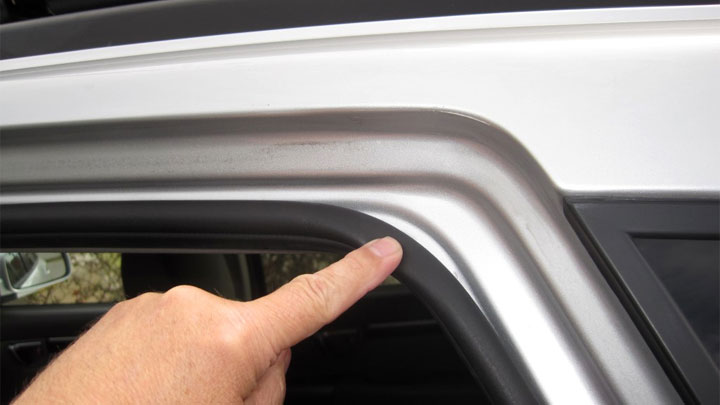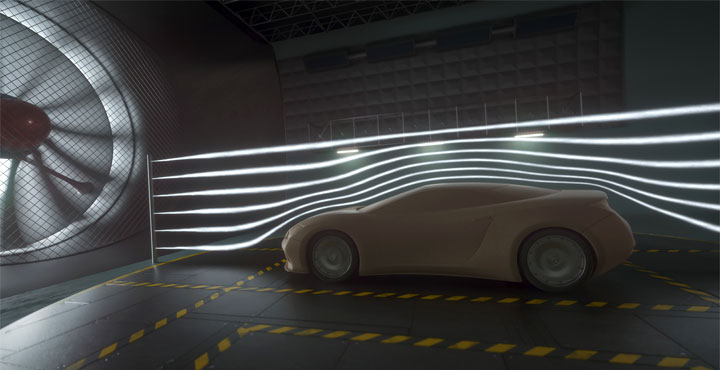How to Reduce Wind Noise in Your Car (Locate the Source)
Wind noise… If only you could enjoy this drive in peace. You could hear yourself think. You could come up with new ideas. You could even be alone with your thoughts — but who’d want that?
The fact that you’re in a 90s hatchback with mismatched tires, a loud exhaust system, a roof rack, and gaps between your window and the frame doesn’t help things.
Sure, you could get a new car, but that would ruin the fun and cost money. Instead, here’s why you’re hearing so much wind noise and what you can do to reduce it!

Understanding Wind Noise
“To defeat thine enemy, you must first understand him.”
I believe it was Napoleon that first made that remark, while on his latest voyage before discovering the new world. It applies here, because we’re trying to destroy wind noise, so we need to learn a little bit about him.
As you drive down the road, imagine your car pushing all of the little hydrogen, nitrogen, oxygen, uranium, and plutonium molecules out of the way. That’s what air is, and it’s constantly onslaughting your whip like some late-night taco bell on your next morning’s toilet bowl.
Now, when the air hits your car and runs over all of the imperfections (there are many) on your vehicle’s surface — we’re talking window seals, mirrors, hood vents, door handles — it makes noise.
Just think back to the last time you rode a bicycle and went down a hill at high speeds. Remember the noise of the wind going past your ears?
It’s the air hitting your bicycle helmet, going around your face, and then as it whooshes over your ear holes, it makes some noise.
Locating the Source of Wind Noise

Drive around (or be a passenger) with the music off. No podcasts. No Joe Rogan. Just you, maybe your partner — if they’re chill — and the open road. Listen for wind noise.
Be the car. Use your ears. And try to figure out where it’s coming from. Is it the doors? Is it the windows? Maybe the sunroof? Pay attention.
You may want to try slightly opening and closing each window one-by-one to help pinpoint the cause of noise.
Still can’t find the source? Stop the car and inspect door and window seals (look for small gaps, cracks, or damage). Look for gaps and small openings around the trunk, side mirrors, door locks, door handles.
Check under the car. Modern cars have all sorts of plastic underbody panels and when correctly in place, they actually help reduce wind noise. But if one gets damaged or slightly dislodged, wind noise can result.
How to Reduce Wind Noise in a Car

Step 1 – Inspect Weatherstripping
Open each of the doors. Inspect the weather stripping for any cracks, or if the adhesive is cracking and falling off. Use some weather stripping adhesive (3M is best) to patch these back up.
Step 3 – Check Doors and Sunroof
Next, inspect your doors for any bends or damage that might prevent them from closing all the way. If they don’t close all the way, some wind will get in.
Check out your sun roof. If it’s open a smidge, it can let wind noise in. Do you have a wind deflector over your sun roof? You could try removing that if you’re not really a sunroof person and see if the wind noise decreases.
Step 3 – Check for Body Damage
Inspect your car for any damage on the surface that could cause wind to enter your vehicle. Any rust spots? Look at those.
Step 4 – Add Sound Deadening
Get some sound deadening mats like Dynamat. You can put these beneath your floorboard and behind the door cards of your doors so that way it reduces outside noise(Including wind).
Impact of Air Pressure
When driving down the road, the air pressure outside of your car is lower than that in your car. This is because you have a constant (more or less) volume of air particles within your vehicle, so it has constant pressure.
The air outside your car has a lot more room to roam and the air pressure is constantly changing, but overall it’s lower.
Most vehicles have vents to equalize the pressure between the inside and outside of your vehicle. These vents are one cause of wind noise because to equalize air pressure, air needs to pass through these vents.
Acoustic Vs Non-Acoustic Windshield
Well, I learned something new today: acoustic glass is a thing.
According to Custom Glass Solutions:
“Acoustic glass is made by laminating two pieces of glass together with a sound-blocking PVB (Polyvinyl Butyral) membrane. The membrane absorbs high-frequency sound waves so they are not transmitted through the glass into the vehicle cab.”
It’s an interesting upgrade you could do to your car that may have impressive results, but let’s dive a little bit deeper, shall we?
I found this from Windshield Experts:
“A recent breakthrough in glass technology is making a significant dent in the amount of noise that reaches occupants. The acoustic windshield uses a sheet of specially developed acoustic vinyl sandwiched between two layers of glass. It reduces noise levels by 6 dB at specific frequencies and 2 to 3 dB overall.”
Those a pretty significant soundproofing benefits, and in real-world terms is about the difference between a motorcycle engine running loud vs a motorcycle engine running quietly.
Considering the average sound level of the interior of your car is between 70-80 db at highway speeds, saving 5+ db could have massive impact on your stress level as well as your hearing loss over prolonged drives.
This is from my own research from multiple different sources, so not just from the sources above, as they also mentioned acoustic glass could have “massive” benefits to your fuel economy — there’s no way that’s true.
A Note on Aerodynamics and Resistance

A slippery, smooth-looking vehicle will move through the air better than a Volvo-like brick. If your car moves through the air with less resistance, it’s going to cause less noise from the air having to change course as it moves around your car. So, if a quiet vehicle is one of your goals, make sure you check out its “drag coefficient”.
For example, one driver’s 1984 Volvo 240 DL sedan has a frontal area of 22.0 ft^2 and a 0.35 coefficient of drag at 60 mph. Look that up. It’s a brick.
The 2023 Toyota Prius has a 0.27 drag coefficient. A Formula 1 car has between 0.07-.1 drag coefficient. A motorcycle can go down to 0.05.
This just illustrates that, given the same testing parameters (ignore the bike and the open-cockpit F1 car), some cars move through the air better than others. This means that, should you choose a normal, passenger car with a lower drag coefficient, it should be quieter than others.
The End?
Hey man, you wanted to learn about wind noise in your vehicle. But, on the off chance you’ve reached the end of this article and just wanna feel something, just know I gotchu. You’re loved.
- How Long Does Paint Protection Film Really Last? - Apr 23, 2024
- How to Reduce Wind Noise in Your Car (Locate the Source) - Nov 22, 2023
- How Long Can You Drive on a Spare Tire? (and How Fast Can You Go?) - Sep 13, 2023
